| Special Forces Operations in March 1945 |
| March 5th, 1945 – March 28th, 1945 |
| Zehden bridgehead |
| SS-Fallschirmjäger-Bataillon 600, SS-Jagdverbände |
| The surviving members of SS-Jagdverband Mitte and SS-Fallschirmjäger-Batallion 600, enter the Zehden bridgehead on March 5th, 1944. They form the core of Kampfgruppe Solar, led by SS-Hauptsturmführer Siegfried Milius, which is integrated into the Infantrie Division z.b.V. 610 under General Lendle’s overall command. The unit defends the locks that control the water level for the Finow and Hohenzollern Canals in the Bridgehead Zehden. They withdraw during the night of March 27th/28th, 1945, crossing the Oder by swimming. Many of them drown. |
| March 15th, 1945 |
| Air Attack on Don Muang airfield |
| 1st Air Commando Group |
| Forty P-51D Mustangs of the 1st Air Commando Group armed with drop tanks attack Don Muang airfield. They manage to destruct of at least 50% of the one hundred Japanese aircraft stationed there. |
| March 17th, 1945 |
| Attack Ludendorff Bridge at Remagen |
| SS-Jagdeinsatz Donau |
| During the cold night, the men swim downstream in the Rhine, carrying torpedo mines. It takes them about one and a half hours to reach Remagen. Schreiber realises the enemy has built two additional pontoon bridges upstream. Despite the challenging conditions, the unit damages and renders the Ludendorff Bridge unusable. Schreiber aims to destroy a pontoon bridge, but the combat swimmers are detected by Canal Defense Light beams. He loses three men, two to the cold, while the remaining swimmers are captured by the Americans, exhausted and half-frozen. |
| March 23rd, 1945 – March 27th, 1945 |
| Operation Plunder |
| 79th Armoured Division |
| The 79th Armoured Division prepares the specialised armour for the Rhine crossing in Operation Plunder. Its key units include Buffalo amphibious vehicles, Sherman Duplex Drive tanks, and the Canal Defence Light squadron. Their objective is to carry assault infantry across the Rhine, support the initial landings with armoured fire, illuminate the crossing, and ensure a rapid establishment of bridgeheads. Four Buffalo regiments are tasked with transporting the infantry of the Highland Division, the 3rd Canadian Division, and the 43rd and 15th (Scottish) Infantry Divisions. Duplex Drive tanks from both British and American units must lead the assault waves. The Canal Defence Light squadron is assigned to illuminate the far bank and guide ferry movements during night operations. By March 1945 Allied forces mass along the Rhine for the final advance into Germany. Operation Plunder is planned and rehearsed on a scale second only to Normandy. Training wings of the 79th Armoured Division work intensively with the infantry and armour they will support. Maintenance becomes critical as many Sherman Duplex Drive tanks need new flotation gear. American forces face shortages and depend heavily on British stocks to make their own Duplex Drive tanks operational. The assault mirrors D-Day. On the night of March 23rd, 1945, troops board Buffaloes and begin the crossing. Duplex Drive tanks enter the river in large numbers and, despite some bogging in the mud of the eastern bank, enough reach firm ground to deliver effective direct fire support. On the nights of March 24th, 1944, and March 25th, 1944, the Canal Defence Light tanks are used for the first time in combat. Their powerful beams guide Buffalo traffic and deter swimmer and mine attacks. German gunners target the lights, but only one vehicle is lost and the squadron completes its task. Between March 24th, 1944, and March 26th, 1944, the four Buffalo regiments make more than 3,800 crossings, transporting the assault brigades with only thirty-eight casualties and nine Buffaloes lost. On March 26th, 1944, Churchill and Brooke cross the Rhine in a Buffalo with Montgomery and Hobart. Churchill addresses the crews and praises their achievement. The crossing is a vast and complex undertaking carried out with exceptional precision. |
| March 24th, 1945 |
| Operation Varsity, 6th Airborne Division |
| The Parachute Regiment, The Glider Regiment, 6th Airborne Division |
| On March 24th, 1945, the 6th Airborne Division participates in Operation Varsity, an airborne assault aimed at facilitating the Allied crossing of the River Rhine. Over the Rhine, the first British formation of the 6th Airborne Division to land is the 8th Parachute Battalion, belonging to the 3rd Parachute Brigade commanded by Brigadier James Hill. The brigade drops onto Drop Zone A nine minutes ahead of schedule, successfully landing despite encountering intense German small-arms and 20-millimetres anti-aircraft fire. As the troops engage enemy forces within the Diersfordter Wald, they sustain several casualties. However, by 11:00 hours, the brigade has effectively cleared the drop zone of German resistance, and all battalions are formed and ready for action. A strategically important position at Schnappenberg is swiftly captured by the 9th Parachute Battalion, operating alongside troops from the 1st Canadian Parachute Battalion. However, the Canadian battalion’s commanding officer, Lieutenant Colonel Jeff Nicklin, is tragically killed by German small-arms fire moments after landing. Despite further casualties, the brigade successfully drives the Germans from the area. By 13:45 hours, Brigadier Hill reports that all of the brigade’s objectives have been fully secured. Canadian medical orderly Corporal Frederick George Topham is later awarded the Victoria Cross for his extraordinary bravery under fire, as he rescued and treated wounded soldiers despite sustaining injuries himself. Following closely behind is the 5th Parachute Brigade, under Brigadier Nigel Poett, landing on Drop Zone B. Although this brigade achieves its landing zone, poor visibility leads to less accurate drops than those of the 3rd Parachute Brigade, complicating the assembly of troops on the ground. The brigade faces immediate resistance from nearby German units, coming under intense small-arms fire, artillery bombardment, and mortar fire, resulting in casualties in their assembly points. Nevertheless, the 7th Parachute Battalion soon clears the area of enemy troops occupying farms and nearby buildings. The 12th and 13th Parachute Battalions promptly secure the brigade’s remaining objectives. Subsequently, the brigade advances eastwards to clear German positions around Schermbeck and engages enemy concentrations near the farmhouse used as headquarters by the 6th Airborne Division. By 15:30 hours, Brigadier Poett confirms that all objectives have been secured and successful links established with other airborne formations. The 6th Airlanding Brigade commanded by Brigadier Hugh Bellamy, lands shortly afterwards by glider. Tasked with capturing several key locations, including the town of Hamminkeln, this brigade is split into company-sized groups, landing across Landing Zones P, O, U, and R under heavy anti-aircraft fire. Difficulties are exacerbated by dense haze and smoke, causing several glider pilots to become disoriented, leading to crashes or landings away from designated areas. Despite this confusion, most gliders land safely enough for the brigade’s battalions to achieve their mission objectives. They swiftly capture three vital bridges across the River Issel intact. Furthermore, with assistance from American troops of the 513th Parachute Infantry Regiment, who inadvertently land in the vicinity, the brigade successfully secures Hamminkeln itself. Shortly after taking the town, Brigadier Bellamy reports all objectives secured and firmly under British control. |
| March 24th, 1945 |
| Operation Varsity, 17th Airborne Division |
| 17th Airborne Division |
| The 17th Airborne Division, comprising the 507th Parachute Infantry Regiment, 513th Parachute Infantry Regiment, and the 194th Glider Infantry Regiment, plays a crucial role in Operation Varsity. Colonel Edson Raff’s 507th Parachute Infantry Regiment lands first but is divided due to poor visibility; Raff rallies his troops, engaging German artillery and securing objectives by the early afternoon. Private George Peters is posthumously awarded the Medal of Honour for his actions during this operation. Following closely, Colonel James Coutts’ 513th Parachute Infantry Regiment encounters severe anti-aircraft fire and misses its drop zone, landing instead near British forces. Quickly reorganising, they support British troops in neutralising German artillery and capturing Hamminkeln, successfully completing all assigned objectives. Private First Class Stuart Stryker also posthumously earns a Medal of Honour for bravery in combat. Finally, the 194th Glider Infantry Regiment, under Colonel James Pierce, lands amidst heavy fire, suffering significant aircraft losses. They immediately engage and defeat multiple German artillery positions targeting Allied Rhine crossings. The regiment secures all objectives, destroying significant German artillery, tanks, and self-propelled vehicles, effectively contributing to the overall success of Operation Varsity. |
| March 24th, 1945 |
| Operation Varsity, Office of Strategic Services Teams |
| Office of Strategic Services |
| Captain Vinciguerra’s Office of Strategic Services detachment consists of sixteen operatives tasked primarily with infiltrating German rear areas immediately upon landing. Their objectives include collecting real-time intelligence on enemy movements, identifying defensive positions, and conducting limited sabotage operations to disrupt German defences during the critical initial hours of the operation. Employing deception and mobility, two agents, Helmut Steltermann and Robert Staub, disguise themselves in German Wehrmacht uniforms, intending to blend in and operate a captured Volkswagen Kübelwagen. Equipped with long-range radios, the team plans to relay intelligence and sabotage enemy communications amidst invasion chaos. Named Operation Algonquin, the Office of Strategic Services detachment divides into four two-man teams: Alsace, Poissy, S&S, and Student. Unlike previous missions, these teams land simultaneously with the main airborne assault forces from the US 17th Airborne and British 6th Airborne Divisions, using military gliders for insertion. However, upon approach, intense German anti-aircraft and machine-gun fire severely disrupts their landing. Vinciguerra’s glider sustains critical damage from flak, causing the destruction of the Kübelwagen tyres and essential communication equipment. Several Office of Strategic Services operatives, including Vinciguerra and Steltermann, are injured but manage to seek cover. Immediately following landing, severe setbacks arise. German defensive fire inflicts casualties, immobilises the Office of Strategic Services detachment, destroys vital equipment, and quickly negates their mission objectives. The intended confusion to mask their movements does not materialise as the operatives land amidst heavily contested drop zones. Steltermann and Staub become trapped in their Wehrmacht uniforms alongside Allied airborne troops, unable to carry out planned deception tasks. Injured, pinned down, and lacking operational mobility, the OSS operatives fail to undertake their intended covert missions. Moreover, the rapid Allied advance soon renders further intelligence-gathering redundant. |
| March 24th, 1945 – May 8th, 1945 |
| Operation Rype |
| Office of Strategic Services Special Forces (Norwegian-American ski troops under Detachment 101) |
| Office of Strategic Services Rype team parachuted into Snåsa, Norway, under the command of Major William Colby. Their mission was to sabotage the Nordland railway and prevent the retreat of over 150,000 German troops stationed in northern Norway. Facing freezing temperatures and mountainous terrain, the operatives used guerrilla tactics to blow bridges, derail trains, and cut communication lines. The operation relied on coordination with Norwegian Resistance groups and Kjevik-based aircraft for resupply. Rype’s actions significantly delayed German withdrawal and were maintained until the German surrender on May 8th, 1945. It was the only U.S. ground combat operation on Norwegian soil during the war. |

